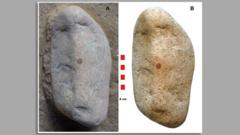Scientists have unveiled findings from a recent excavation in the San Lázaro rock shelter in Segovia, Spain, where they uncovered a pebble believed to have been decorated by a Neanderthal 43,000 years ago. The rock features a distinct red dot, interpreted as an artistic representation of a human face, lending credence to the idea that Neanderthals engaged in symbolic behavior. Researchers assert that the fingerprint, confirmed to belong to a male adult, is the earliest evidence of Neanderthal-created portable art in Europe.
Excavation efforts, led by Prof. María de Andrés-Herrero from the University of Complutense in Madrid, began five years ago, and the discovery of the rock beneath significant sediment layers has sparked intrigue within the scientific community. Utilizing multi-spectrum analysis, the team validated the presence of red ochre pigment, which does not naturally occur in the shelter. This finding implies that the Neanderthal intentionally brought the pigment to the site to create an artwork, showcasing their capacity for abstract thinking and creativity.
Prof. de Andrés-Herrero emphasizes the significance of this pebble in challenging previous notions about Neanderthal cognitive abilities, as it represents the first known pigment-marked object within an archaeological context associated with Neanderthals. Additionally, the unique circumstances surrounding its discovery suggest that it was made for artistic expression, underscoring the depth of Neanderthal thought and culture, significantly contributing to the discourse surrounding human ancestry and artistic practices of early hominins.
Excavation efforts, led by Prof. María de Andrés-Herrero from the University of Complutense in Madrid, began five years ago, and the discovery of the rock beneath significant sediment layers has sparked intrigue within the scientific community. Utilizing multi-spectrum analysis, the team validated the presence of red ochre pigment, which does not naturally occur in the shelter. This finding implies that the Neanderthal intentionally brought the pigment to the site to create an artwork, showcasing their capacity for abstract thinking and creativity.
Prof. de Andrés-Herrero emphasizes the significance of this pebble in challenging previous notions about Neanderthal cognitive abilities, as it represents the first known pigment-marked object within an archaeological context associated with Neanderthals. Additionally, the unique circumstances surrounding its discovery suggest that it was made for artistic expression, underscoring the depth of Neanderthal thought and culture, significantly contributing to the discourse surrounding human ancestry and artistic practices of early hominins.





















